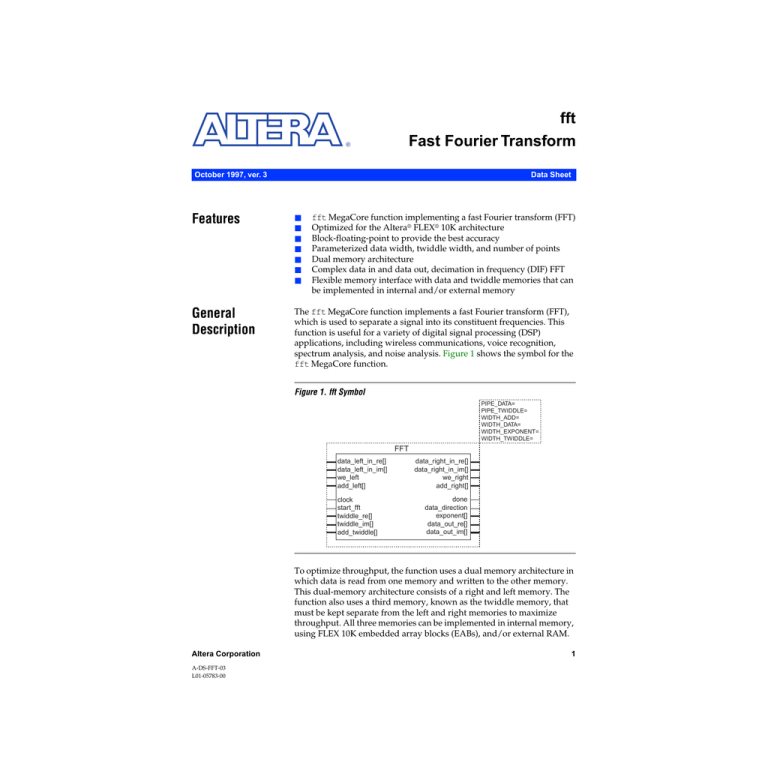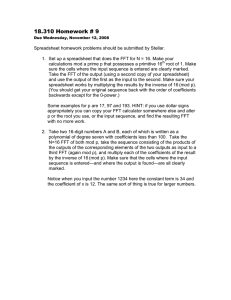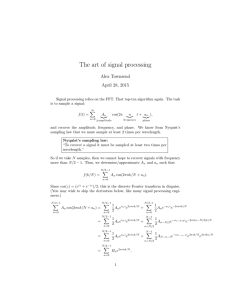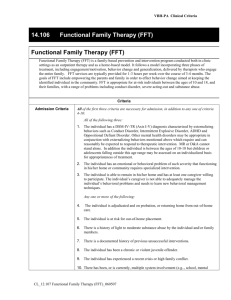
®
fft
Fast Fourier Transform
October 1997, ver. 3
Data Sheet
Features
■
■
■
■
■
■
■
General
Description
The fft MegaCore function implements a fast Fourier transform (FFT),
which is used to separate a signal into its constituent frequencies. This
function is useful for a variety of digital signal processing (DSP)
applications, including wireless communications, voice recognition,
spectrum analysis, and noise analysis. Figure 1 shows the symbol for the
fft MegaCore function.
fft MegaCore function implementing a fast Fourier transform (FFT)
Optimized for the Altera® FLEX® 10K architecture
Block-floating-point to provide the best accuracy
Parameterized data width, twiddle width, and number of points
Dual memory architecture
Complex data in and data out, decimation in frequency (DIF) FFT
Flexible memory interface with data and twiddle memories that can
be implemented in internal and/or external memory
Figure 1. fft Symbol
PIPE_DATA=
PIPE_TWIDDLE=
WIDTH_ADD=
WIDTH_DATA=
WIDTH_EXPONENT=
WIDTH_TWIDDLE=
FFT
data_left_in_re[]
data_left_in_im[]
we_left
add_left[]
clock
start_fft
twiddle_re[]
twiddle_im[]
add_twiddle[]
data_right_in_re[]
data_right_in_im[]
we_right
add_right[]
done
data_direction
exponent[]
data_out_re[]
data_out_im[]
To optimize throughput, the function uses a dual memory architecture in
which data is read from one memory and written to the other memory.
This dual-memory architecture consists of a right and left memory. The
function also uses a third memory, known as the twiddle memory, that
must be kept separate from the left and right memories to maximize
throughput. All three memories can be implemented in internal memory,
using FLEX 10K embedded array blocks (EABs), and/or external RAM.
Altera Corporation
A-DS-FFT-03
L01-05783-00
1
fft Fast Fourier Transform Data Sheet
AHDL Function Prototype
The Altera Hardware Description Language (AHDL) Function Prototype
for the fft is shown below:
FUNCTION fft (clock, start_fft,
data_left_in_re[WIDTH_DATA-1..0],
data_left_in_im[WIDTH_DATA-1..0],
data_right_in_re[WIDTH_DATA-1..0],
data_right_in_im[WIDTH_DATA-1..0],
twiddle_re[WIDTH_TWIDDLE-1..0],
twiddle_im[WIDTH_TWIDDLE-1..0])
WITH (WIDTH_DATA, WIDTH_TWIDDLE, PIPE_DATA,
PIPE_TWIDDLE, WIDTH_EXPONENT, FFT_DIRECTION,
WIDTH_ADD, EXPONENT_INITIAL_VALUE)
RETURNS (done, data_direction, we_left,
add_left[WIDTH_ADD-1..0], we_right,
add_right[WIDTH_ADD-1..0],
add_twiddle[WIDTH_ADD-2..0],
data_out_re[WIDTH_DATA-1..0],
data_out_im[WIDTH_DATA-1..0],
exponent[WIDTH_EXPONENT-1..0]);
VHDL Component Declaration
The VHDL Component Declaration for the fft is shown below:
COMPONENT fft
GENERIC(
WIDTH_DATA : POSITIVE;
WIDTH_TWIDDLE : POSITIVE;
PIPE_DATA : INTEGER;
PIPE_TWIDDLE : INTEGER;
WIDTH_EXPONENT : POSITIVE;
WIDTH_ADD : POSITIVE;
EXPONENT_INITIAL_VALUE : INTEGER);
PORT(
clock : IN STD_LOGIC := '0';
start_fft : IN STD_LOGIC;
data_left_in_re, data_left_in_im,
data_right_in_re, data_right_in_im : IN
STD_LOGIC_VECTOR(WIDTH_DATA-1 DOWNTO 0);
twiddle_re, twiddle_im : IN
STD_LOGIC_VECTOR(WIDTH_TWIDDLE-1 DOWNTO 0);
done, data_direction, we_left : OUT STD_LOGIC;
add_left : OUT STD_LOGIC_VECTOR(WIDTH_ADD-1
2
Altera Corporation
fft Fast Fourier Transform Data Sheet
DOWNTO 0);
we_right : OUT STD_LOGIC;
add_right : OUT STD_LOGIC_VECTOR(WIDTH_ADD-1
DOWNTO 0);
add_twiddle : OUT STD_LOGIC_VECTOR(WIDTH_ADD-2
DOWNTO 0);
data_out_re, data_out_im : OUT
STD_LOGIC_VECTOR(WIDTH_DATA-1 DOWNTO 0);
exponent : OUT_STD_LOGIC_VECTOR(WIDTH_EXPONENT-1
DOWNTO 0));
END COMPONENT;
Ports
Table 1 describes the ports for the fft.
Table 1. fft Ports
Name
Type
Required
Description
clock
Input
Yes
start_fft
Input
Yes
Starts the fft after data is loaded.
data_left_in_re[]
Input
Yes
Real data input from the left memory.
data_left_in_im[]
Input
Yes
Imaginary data input from the left memory.
data_right_in_re[]
Input
Yes
Real data input from the right memory.
data_right_in_im[]
Input
Yes
Imaginary data input from the right memory.
twiddle_re[]
Input
Yes
Real twiddle input from the twiddle memory.
twiddle_im[]
Input
Yes
Imaginary data input from the twiddle memory.
done
Output
Yes
Goes high when the fft has completed the calculation.
data_direction
Output
Yes
When high, the fft reads data from the left memory and
writes data to the right memory. When low, the inverse
operation is performed.
we_left
Output
Yes
Write enable for the left memory.
we_right
Output
Yes
Write enable for the right memory.
add_left[]
Output
Yes
Address bus for the left memory.
add_right[]
Output
Yes
Address bus for the right memory.
add_twiddle[]
Output
Yes
Address bus for the twiddle memory.
data_out_re[]
Output
Yes
Real data output to both left and right memories.
data_out_im[]
Output
Yes
Imaginary data output to both left and right memories.
exponent[]
Output
Yes
Exponent of the resultant data. Valid after done goes high.
Exponent of the block-floating-point notation. All data
should be scaled by 2exponent[].
Altera Corporation
Clock signal.
3
fft Fast Fourier Transform Data Sheet
Parameters
Table 2 describes the parameters for the fft.
Table 2. fft Parameters
Name
Value
Description
PIPE_DATA
Integer
Number of clock cycles after add_left[] or add_right[] becomes
active that the data will be valid at data_left_in_re[],
data_left_in_im[], data_right_in_re[], or
data_right_in_im[].
PIPE_TWIDDLE
Integer
The number of clock cycles after add_twiddle[] becomes active that
twiddle_re[] or twiddle_im[] becomes active.
WIDTH_ADD
Integer
Width of the data address buses. The number of points in the fft is
2WIDTH_ADD.
WIDTH_DATA
Integer
Data width.
WIDTH_EXPONENT
Integer
Number of bits in the exponent.
WIDTH_TWIDDLE
Integer
Twiddle width.
Functional
Description
The fft function implements a decimation in frequency (DIF) algorithm
and contains all the core logic functions necessary to compute an FFT. To
maximize flexibility, the fft function does not include a memory or I/O
interface. The memory and I/O interface is dependent upon the end
application, and thus must be customized to fit each application.
Figure 2 shows the basic butterfly operation performed by the DIF
algorithm.
Figure 2. Basic DIF FFT Butterfly Operation
Blue lines indicate negative numbers.
x[0]
X[0]
x[0]
X[0]
x[1]
X[1]
=
x[1]
X[1]
–1
k
WN
where:
4
X[0] = x[0] + x[1]
k
X[1] = WN (x[0] – x[1])
k
WN = Twiddle = e–j 2 π k/N = cos(2πk/N) – j sin(2πk/N)
k
WN
k = 0 to (N/2 – 1)
N = Number of points in FFT
j = –1
Altera Corporation
fft Fast Fourier Transform Data Sheet
Figure 3 shows a sample 8-point DIF FFT algorithm as implemented by
the fft function. The input data addresses are in normal order, and the
output data addresses are in bit-reversed order. However, dedicated
hardware can be easily added to address the memories so that data
appears in normal order for both inputs and outputs.
Figure 3. 8-Point DIF FFT Algorithm
Solid blue lines indicate negative numbers.
Pass 1
x[000]
Pass 2
0
Pass 3
0
W8
0
W8
W8
x[001]
x[010]
0
1
0
W8
W8
0
2
2
x[101]
x[110]
2
3
0
W8
W8
Left
Memory
1
1
X[010]
2
X[011]
3
X[100]
4
X[110]
5
X[101]
6
X[111]
7
W8
x[111]
Right
Memory
X[001]
W8
W8
W8
0
W8
x[011]
x[100]
X[000]
Right
Memory
Left
Memory
Address
The fft_on_chip reference design includes a memory and I/O
interface as well as dedicated hardware for addressing data in
normal order for both inputs and outputs. Example 1 on page 8
and Example 2 on page 10 describe the implementation of the
fft_on_chip reference design.
When processing data, the fft alternates which memory it reads from
and writes to on each pass. For example, on Pass 1 in Figure 3, the fft
simultaneously reads data from the right memory, performs the butterfly
operation, and writes the result to the left memory. On Pass 2, the fft
simultaneously reads the result from the left memory, performs the next
step of the DIF algorithm, and writes the result to the right memory. The
fft continues this process until the calculation is complete.
Altera Corporation
5
fft Fast Fourier Transform Data Sheet
The number of points in the fft determines which memory the fft reads
first. When the number of points is an odd power of 2 (e.g., 23 = 8, 25 = 32),
data is always read from the right memory on the first pass through the
fft. When the number of points is an even power of 2 (e.g., 24 = 16,
26 = 64), the fft switches which memory it reads first after each complete
calculation. The data_direction output indicates which memory the
fft is reading from and writing to.
Twiddle Generation
The data is multiplied by twiddles (i.e., coefficients) each time it passes
through the fft. Each twiddle (W) is calculated by the equation:
k
WN = e
( – j2πk ) ⁄ N
= cos ( 2πk ⁄ N ) – j sin ( 2πk ⁄ N )
where: N = Number of points in fft = 2WIDTH_ADD
k = 0 to (N/2 – 1)
–1
j =
The real part of the twiddle is cos(2πk/N) and the imaginary part is
–sin(2πk/N). Both twiddle outputs must be stored in the twiddle memory.
The twiddle utility program distributed with the fft MegaCore function
automatically generates an EAB Memory Initialization File (.mif) that
contains all the twiddle data. This MIF can be easily translated to other
formats for use in an external ROM.
1
For help on the syntax, type twiddle from the UNIX or DOS
command prompt.
Number Representation
All buses in and out of the fft are in two’s complement fractional
notation, in which the numbers range from –1 to 1. The input data is
always in two’s complement fractional notation, with one bit to the left of
the binary point and WIDTH_DATA – 1 bits to the right. For example, the
decimal number 0.5 is represented as 0.1000000B, and –0.5 is 1.1000000B.
The smallest 8-bit wide number that can be represented in two’s
complement fractional notation is –1.0 and the largest number is:
WIDTHTWIDDLE – 1
2
–1
127
-------------------------------------------------------- = --------- = 0.9922
WIDTHTWIDDLE – 1
128
2
6
Altera Corporation
fft Fast Fourier Transform Data Sheet
Twiddle data is in inverted two’s complement notation (i.e., the decimal
number 0.5 is represented as 1.1000000B, and –0.5 is 0.1000000B). The
twiddle data uses this notation because the most used twiddle—twiddle
0
zero ( WN )—has the value of 1.0 + j0 and less error is accumulated when
0
0
WN can be represented exactly. Although the accuracy of W N ⁄ 4 suffers
slightly, the final result is more accurate because this twiddle is used less
in the FFT calculation.
Memory
Interface
The fft contains the core functions necessary to compute an FFT and
does not include memory or an I/O interface. The function does not
include a memory or I/O interface so the user has the most flexibility in
every application. FLEX 10K devices contain a finite amount of memory,
so not all memory configurations can be accommodated on-chip. Table 3
shows the available memory configurations for EPF10K100 and
EPF10K50 devices.
Table 3. Available Configurations in EPF10K100 & EPF10K50 Devices
Device
EABs
Availabl
e
EPF10K100
12
EPF10K50
10
Note (1)
Data
Width
(Bits)
Twiddle
Memory Implementation
Width
Twiddles & Data in Twiddles in EABs & Twiddles in External
(Bits)
EABs
Data in External RAM RAM & Data in EABs
≤8
≤8
Points
EABs
Points
EABs
Points
EABs
512
10
2,048
8
512
8
9 to 16
≤8
256
10
2,048
8
256
8
9 to 16
9 to 16
256
12
1,024
8
256
8
> 16
> 16
Note (2)
Note (2)
Note (2)
Note (2)
Note (2)
Note (2)
≤8
≤8
512
10
2,048
8
512
8
9 to 16
≤8
256
10
2,048
8
256
8
9 to 16
9 to 16
Note (2)
Note (2)
1,024
8
256
8
> 16
> 16
Note (2)
Note (2)
Note (2)
Note (2)
Note (2)
Note (2)
Notes:
(1)
(2)
If both the data and twiddles are in external RAM, the design can use an unlimited number of points.
The device cannot support this configuration because the RAM required exceeds the available memory in the
device.
Altera Corporation
7
fft Fast Fourier Transform Data Sheet
Pipelining
The designer can choose the number of pipeline stages in the memory
path, allowing a trade-off between size and speed for a particular memory
interface. For example, the fft_on_chip function described in
“Example 1: On-Chip RAM, Odd Number of Passes, with No Data
Buffering” uses a data pipeline delay of three, and a twiddle pipeline
delay of two. Because the twiddle memory in the fft_on_chip function
is a synchronous ROM with registered inputs and outputs, the
PIPE_TWIDDLE parameter is set to two. The data memory is a
synchronous RAM with registered inputs (address) and outputs (data),
and with multiplexers on the data, address, and write enable inputs.
Because these multiplexers are pipelined to maximize performance, the
delay from the address/control valid to data valid on the data ports is
three. Therefore, PIPE_DATA is set to three.
Example Implementations
When using the fft, the majority of the design effort will be spent on
creating the memory and I/O interface. The user can choose from a wide
variety of memory and I/O interface schemes; this section describes four
of these schemes:
■
■
■
■
Example 1: On-chip RAM, odd number of passes (even number of
address bits), with no data buffering
Example 2: On-chip RAM, even number of passes, with no data
buffering
Example 3: Off-chip RAM, odd number of passes, with no data
buffering
Example 4: Off-chip RAM, odd number of passes, with data buffering
Example 1: On-Chip RAM, Odd Number of Passes, with No Data Buffering
This example describes the same memory architecture provided by the
fft_on_chip reference design. The right, left, and twiddle memories are
all implemented in FLEX 10K EABs. Data is loaded into the right memory
and processed by the fft. When the fft is not processing data, data can
be loaded and unloaded from both memories simultaneously. Figure 4
shows a block diagram of this implementation.
8
Altera Corporation
fft Fast Fourier Transform Data Sheet
Figure 4. Block Diagram of Example 1
en
Load Counter
sclr
q
load_bank_enable
load_bank_reset
unload_bank_enable
en
Unload Counter
sclr q
unload_bank_reset
m
m
load_nrun
q[]
we
Left
Memory add[]
n
0
m
1
m
we_right
add_right[]
start_fft
r
m-1
q
add
twiddle_im[]
add_twiddle[]
n
q[]
Right
we
Memory
add[]
0
1
m
fft
start_fft
n
data_right_in[]
data_left_in[]
we_left
add_left[]
d
Twiddle
Memory
data_out_re[]
data_out_im[]
n
d
m
0
m
1
done
exponent[]
m
n
p
done
exponent[]
data_out[]
n
n
n
data_in
where:
n =
m=
p =
r =
0
1
2 × WIDTH_DATA
WIDTH_ADD
WIDTH_EXPONENT
WIDTH_TWIDDLE
Memory & I/O Interface
Because data passes through the fft an odd number of times, the fft
always reads new data from the right memory and writes the result to the
left memory. This scheme can cause a problem if both the fft and the I/O
interface require access to the right and left memory control and data
buses. However, this problem can be avoided by placing multiplexers on
the data and address buses. Because these multiplexers can cause a
performance bottleneck if they are not pipelined, a register is placed after
the data and address multiplexers. Since the EAB is used with both
registered inputs and outputs to maintain performance, the delay from
address valid to data valid is 3. Therefore, PIPE_DATA is set to 3.
Altera Corporation
9
fft Fast Fourier Transform Data Sheet
Load & Unload Addressing
The incoming data is in normal bit order, and the outgoing data (as placed
in the left memory) is in bit-reversed order. Therefore, the designer can
use either one or two counters to load and unload the memories. If one
counter is used, the right memory receives the load counter output in
normal bit order, and the left memory receives the load counter output in
bit-reversed order. When the I/O interface has one address counter, loads
and unloads must be completed simultaneously. If two counters are used
(as shown in Figure 4), data can be individually loaded and unloaded
once done is asserted.
Twiddle Memory
The twiddle memory interface is simple to design because the twiddle
memory is always read-only. The twiddle memory does not require a
write enable signal or an I/O interface, and thus the twiddle memory is
connected directly to the fft. The twiddle memory has registered inputs
and outputs, so the PIPE_TWIDDLE parameter is set to 2.
Usage
To load data into the right memory, assert load_nrun for N + 1 clock
cycles, and assert load_bank_enable for N cycles while placing data on
the data_in port. The load_nrun input is then deasserted to return
control to the fft. On the next clock cycle, assert start_fft for one clock
cycle to begin computation. After the fft has finished processing data
and has written the result to the left memory, the fft asserts the done
output.
Example 2: On-Chip RAM, Even Number of Passes, with No Data Buffering
Example 2 is similar to Example 1, except the data passes through the fft
an even number of times. To allow maximum throughput in this scheme,
the fft alternates the first memory it reads after each complete FFT
calculation (i.e., for the first FFT calculation, fft reads new data from the
right memory; for the second FFT calculation, the fft reads new data
from the left memory.) When the data passes through the fft an even
number of times, the fft reads new data from one memory, processes the
data, and writes the result back to the same memory. Because each
memory is storing either new data or the result of a calculation, the I/O
interface should be able to load new data into one memory and unload the
result from the other memory.
10
Altera Corporation
fft Fast Fourier Transform Data Sheet
Figure 5 shows a block diagram of Example 2. This example uses a
multiplexing scheme to allow both load and unload addresses to access
the right and left memories. The multiplexing scheme also allows data to
be loaded and unloaded to and from both memories. To maintain
performance, the multiplexers are pipelined, thus adding a stage of delay
between the address counters and the left and right memories. An extra
stage of delay is added in the data_in path so that load_bank_enable,
data_in, left_address, and right_address are all active during the
same clock cycles.
Figure 5. Block Diagram of Example 2
en
Load Counter
sclr
q
load_bank_enable
load_bank_reset
unload_bank_enable
en
Unload Counter
sclr q
unload_bank_reset
0 1
0 1
n
0
1
load_nrun
n
m
Left
Memory
q[]
n
we
add[]
m
0
1
n
data_right_in[]
we_right
add_right[]
data_left_in[]
we_left
add_left[]
0
1
d
0
1
m
m
fft
m
m
add[]
q[]
Twiddle
Memory
m–1
r
twiddle_im[]
add_twiddle[]
n
done
exponent[]
data_out[]
q[]
Right
we Memory
add[]
d
0
1
n
start_fft
start_fft
data_out_re[]
data_out_im[]
p
done
exponent[]
n
n
0
1
0
1
n
data_in
where:
n
m
n
p
r
=
=
=
=
WIDTH_ADD
2 × WIDTH_DATA
WIDTH_EXPONENT
WIDTH_TWIDDLE
Altera Corporation
11
fft Fast Fourier Transform Data Sheet
Example 3: Off-Chip RAM, Odd Number of Passes, without Data Buffering
Using off-chip RAM allows the fft to be longer than 256 points. An even
longer fft can be created by using external synchronous static RAM
(SSRAM), while still maintaining a high clock rate. The SSRAM used in
this example is a synchronous cache RAM intended for use with highspeed microprocessors. This type of RAM is available from a variety of
vendors.
This architecture is similar to the architectures used in Examples 1 and 2,
except for the use of off-chip RAM. The address, data multiplexing, and
pipelining schemes remain the same as Examples 1 and 2. The only
difference is that the RAM does not have separate data_in and data_out
ports and instead uses bidirectional ports. Therefore, this design must use
bidirectional pins on the FLEX 10K device that are used as output pins
when writing and input pins at all other times.
Example 4: Off-Chip RAM, Odd Number of Passes, with Data Buffering
In examples 1, 2, and 3, new data cannot be captured when the fft is
processing data because all of the RAM is in use. Through the use of four
memories (i.e., right 1, right 2, left 1, and left 2 memories), this example
allows new data to be captured while the fft is processing the current
data. While the fft is processing data from the right 1 and left 1
memories, new data is being loaded into the left 2 memory. When both the
left 2 memory is full and the fft has finished processing data, the left 1
and left 2 memories are swapped and the right 1 and right 2 memories are
swapped. Then, the start_fft signal is immediately asserted to begin
processing data from the left 2 and right 2 memories. While the fft is
processing data from the left 2 and right 2 memories, the left 1 and right 1
memories are loaded and unloaded.
®
101 Innovation Drive
San Jose, CA 95134
(408) 544-7000
http://www.altera.com
Applications Hotline:
(800) 800-EPLD
Customer Marketing:
(408) 544-7104
Literature Services:
(888) 3-ALTERA
lit_req@altera.com
12
Altera, MAX, MAX+PLUS, MAX+PLUS II, MegaCore, FLEX, FLEX 10K, EPF10K100, and EPF10K50 are
trademarks and/or service marks of Altera Corporation in the United States and other countries. Altera
acknowledges the trademarks of other organizations for their respective products or services mentioned in this
document. Altera products are protected under numerous U.S. and foreign patents and pending applications,
maskwork rights, and copyrights. Altera warrants performance of its semiconductor products to current
specifications in accordance with Altera’s standard warranty, but reserves the right to make changes to any
products and services at any time without notice. Altera assumes no responsibility or liability arising out of
the application or use of any information, product, or service described herein except as
expressly agreed to in writing by Altera Corporation. Altera customers are advised to
obtain the latest version of device specifications before relying on any published
information and before placing orders for products or services.
Copyright 1997 Altera Corporation. All rights reserved.
Altera Corporation
Printed on Recycled Paper.






